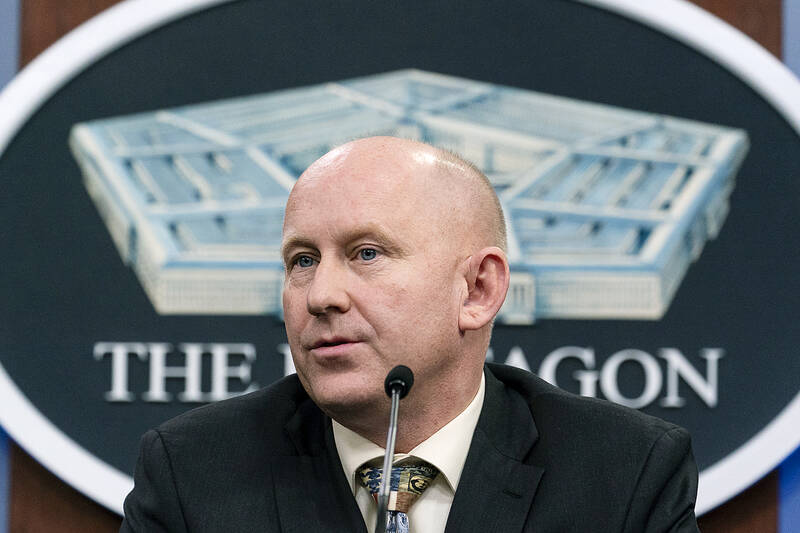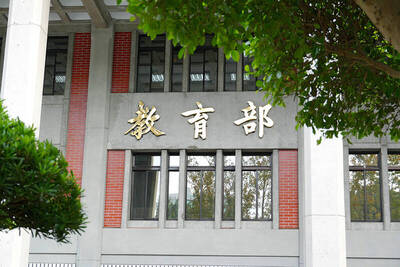China would carefully weigh its military capabilities and costs of an attack before launching an amphibious assault against Taiwan, former acting US secretary of the army John Whitley said yesterday.
He made the remarks during a speech in Taipei, entitled “An Economist goes to the Army.” The economist-turned-military official is visiting Taiwan for the first time at the invitation of National Taiwan University’s Department of Economics.
During a question-and-answer session, he was asked about the factors the Chinese Communist Party might take into account before launching an invasion of Taiwan.

Photo: AP
“The first and foremost question is whether you have the military equipment and specialized training force to succeed. A cross-strait invasion would be one of the hardest military maneuvers ever — you have a lot of water, and a lot of things could go wrong. You also have beaches and land that is not ideal for landing,” Whitley said.
“My understanding is that China relatively understood that they did not have sufficient training and stockpile of ammunition to do that for many years. That has been the focus of their defense buildup, which has led to a dramatic increase in defense spending,” he added.
Beijing also needs to calculate the costs of launching a war against Taiwan and ask itself if an amphibious operation is worth it, Whitley said.
“And if the operation does not succeed, you are looking at existential threat to the Chinese Communist Party. China is very cognizant that this is going to be a high-risk, high-cost operation, and that they would not like to do it unless they have to. They would try politically and economically coercive means first before taking military actions,” he said.
Despite the costs, China might still attack Taiwan as the US government shifts its focus from the Middle East to conflicts in the Asia-Pacific region, which presents Beijing with an opportunity, he said.
Last year, the Taiwanese government announced that defense spending for this year would jump 13.9 percent to NT$58.63 billion (US$1.9 billion), or about 2.4 percent of GDP.
Although it was the largest defense budget increase in recent years, it pales in comparison with China’s military spending, which reached 1.56 trillion yuan (US$220.7 billion) this year.
Defense spending is a “measure of affordability, not a measure of demand,” Whitley said, adding that the demand side of the equation depends on strategic plans.
“The US can grow significantly while maintaining 3 to 4 percent for defense spending. During the Cold War, US defense spending was about 8 percent. That is the calibration range of what tends to be affordable in a vibrant democracy. If you need to spend it, spend it in the way you can afford,” Whitley said.
Whitely also identified three levels of problems in modernizing Taiwanese troops.
“It would be nice if we have the luxury of time that we can get a year or two to get our concept of defense right, and take a couple more years to get strategic plans right before figuring out what our training is,” he said.
“The challenge is we are doing all of this at the same time because you cannot stop military training, and have to make decisions for acquisitions now without the benefit of perfectly developing an analytic framework,” he added.
Whitley said that it should not be difficult to convince the public to increase defense spending.
“After the crackdown on dissidents in Hong Kong and the Russian invasion of Ukraine, my sense is that there are very few people who do not think [the Chinese military threat] is a serious problem,” he said.

The Ministry of Education (MOE) is to launch a new program to encourage international students to stay in Taiwan and explore job opportunities here after graduation, Deputy Minister of Education Yeh Ping-cheng (葉丙成) said on Friday. The government would provide full scholarships for international students to further their studies for two years in Taiwan, so those who want to pursue a master’s degree can consider applying for the program, he said. The fields included are science, technology, engineering, mathematics, semiconductors and finance, Yeh added. The program, called “Intense 2+2,” would also assist international students who completed the two years of further studies in

The brilliant blue waters, thick foliage and bucolic atmosphere on this seemingly idyllic archipelago deep in the Pacific Ocean belie the key role it now plays in a titanic geopolitical struggle. Palau is again on the front line as China, and the US and its allies prepare their forces in an intensifying contest for control over the Asia-Pacific region. The democratic nation of just 17,000 people hosts US-controlled airstrips and soon-to-be-completed radar installations that the US military describes as “critical” to monitoring vast swathes of water and airspace. It is also a key piece of the second island chain, a string of

Taiwan will now have four additional national holidays after the Legislative Yuan passed an amendment today, which also made Labor Day a national holiday for all sectors. The Chinese Nationalist Party (KMT) and Taiwan People’s Party (TPP) used their majority in the Legislative Yuan to pass the amendment to the Act on Implementing Memorial Days and State Holidays (紀念日及節日實施辦法), which the parties jointly proposed, in its third and final reading today. The legislature passed the bill to amend the act, which is currently enforced administratively, raising it to the legal level. The new legislation recognizes Confucius’ birthday on Sept. 28, the

A magnitude 5.9 earthquake that struck about 33km off the coast of Hualien City was the "main shock" in a series of quakes in the area, with aftershocks expected over the next three days, the Central Weather Administration (CWA) said yesterday. Prior to the magnitude 5.9 quake shaking most of Taiwan at 6:53pm yesterday, six other earthquakes stronger than a magnitude of 4, starting with a magnitude 5.5 quake at 6:09pm, occurred in the area. CWA Seismological Center Director Wu Chien-fu (吳健富) confirmed that the quakes were all part of the same series and that the magnitude 5.5 temblor was